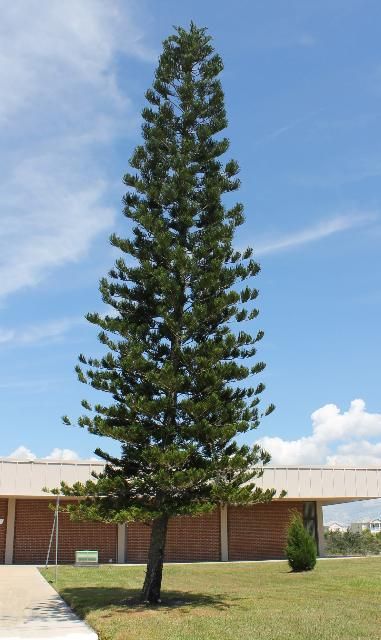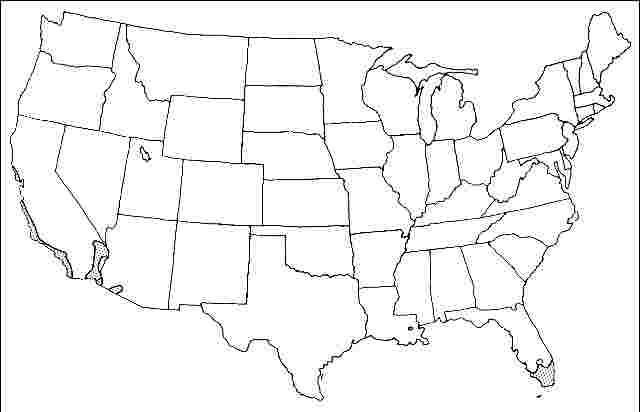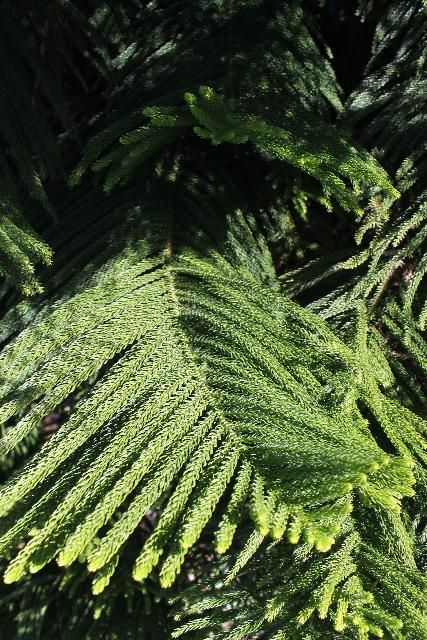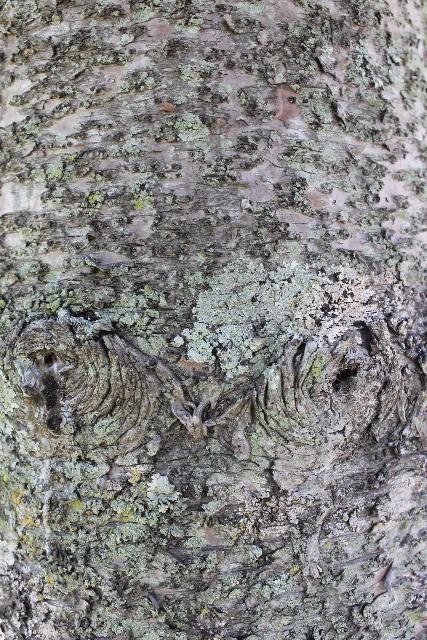Introduction
This large evergreen has a single upright trunk, tiered branching habit, and a narrow pyramidal or columnar shape. Eventually reaching a height of about 80 feet, the tree possesses a rapid growth rate. The tree would grow taller, but lightning frequently limits height growth in the eastern United States. The bright green, <2-inch-long, individual leaves on young trees are lanceolate and look somewhat like spruce or fir needles at first glance. Mature leaves are somewhat contorted on twisted branches and scale-like. Both leaf types appear on the tree at the same time. The trunk is often curved and swollen at the base and black. The large, spiny, 10- to 15-pound cones are rare in cultivation.

General Information
Scientific name: Araucaria heterophylla
Pronunciation: air-ah-KAIR-ee-uh het-er-oh-FILL-uh
Common name(s): Norfolk Island-pine
Family: Araucariaceae
USDA hardiness zones: 10A through 11 (Figure 2)
Origin: native to Norfolk Island, Australia
UF/IFAS Invasive Assessment Status: not considered a problem species at this time, may be recommended (North, Central, South)
Uses: indoors; specimen

Description
Height: 60 to 80 feet
Spread: 12 to 20 feet
Crown uniformity: symmetrical
Crown shape: pyramidal, columnar
Crown density: open
Growth rate: fast
Texture: fine
Foliage
Leaf arrangement: spiral (Figure 3)
Leaf type: simple
Leaf margin: entire
Leaf shape: linear, needle-like (filiform)
Leaf venation: parallel
Leaf type and persistence: evergreen, needled evergreen
Leaf blade length: < 2 inches
Leaf color: bright green
Fall color: no color change
Fall characteristic: not showy

Flower
Flower color: unknown
Flower characteristics: not showy
Fruit
Fruit shape: oval, cone
Fruit length: 5 inches
Fruit covering: dry or hard; spiny
Fruit color: green to brown
Fruit characteristics: does not attract wildlife; showy; fruit/leaves a litter problem
Trunk and Branches
Trunk/branches: branches don't droop; not showy; typically one trunk; no thorns
Bark: gray brown and smooth, becoming darker, rougher, and breaking into small, scaly plates with age
Pruning requirement: little required
Breakage: resistant
Current year twig color: green, brown
Current year twig thickness: medium
Wood specific gravity: unknown

Credit: Gitta Hasing
Culture
Light requirement: full sun
Soil tolerances: clay; sand; loam; alkaline; acidic; well-drained
Drought tolerance: high
Aerosol salt tolerance: can form large surface roots
Winter interest: no
Outstanding tree: no
Ozone sensitivity: unknown
Verticillium wilt susceptibility: unknown
Pest resistance: resistant to pests/diseases
Use and Management
Although they provide some shade, they are not suitable for patios or terraces because they are too large and large surface roots are common. In addition, columnar-formed trees generally cast limited shade due to the narrow crown. Many people forget how tall these trees grow. They often have an attractive pyramidal form (like a fir or spruce tree) when they are small, but they quickly grow too tall for most residential sites. They can live as a house plant for a long time if not overwatered.
Growing best in full sun locations, this tree thrives on a variety of soils and is moderately salt tolerant. Young plants should be watered well, especially during periods of drought. Be sure to prune out multiple trunks or leaders as they should be grown with one central leader.
Propagation is by seeds or cuttings of erect shoot tips only.
Pests
Scale.
Diseases
No diseases are of major concern. Sooty mold and leaf spot are minor problems.
References
Koeser, A. K., Hasing, G., Friedman, M. H., and Irving, R. B. 2015. Trees: North & Central Florida. University of Florida Institute of Food and Agricultural Sciences.
Koeser, A.K., Friedman, M.H., Hasing, G., Finley, H., Schelb, J. 2017. Trees: South Florida and the Keys. University of Florida Institute of Food and Agricultural Sciences.